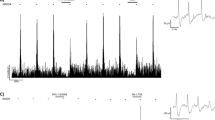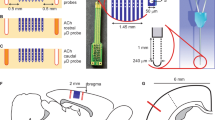Abstract
Acetylcholine (ACh) is considered to act as a neurotransmitter in the mammalian brain by binding to membrane receptors and bringing about a change in neurone excitability. In the case of muscarinic receptors, cell excitability is usually increased1; this effect results from a closure of membrane potassium channels in cortical cells2,3. However, some central neurones are inhibited by ACh1, and we hypothesized that these two opposite effects of ACh resulted from interactions with different subtypes of muscarinic receptor. We made intracellular recordings from neurones in the rat nucleus parabrachialis, a group of neurones in the upper pons some of which themselves synthesize ACh4,5. ACh and muscarine caused a membrane hyperpolarization which resulted from an increase in the membrane conductance to potassium ions. The muscarinic receptor subtype was characterized by determining the dissociation equilibrium constant (KD) for pirenzepine during the intracellular recording; the value of ∼600 nM indicates a receptor in the M2 class. This muscarinic receptor is quite different from that which brings about a decrease in potassium conductance in other neurones, which has a pirenzepine KD of ∼10nM (M1 receptors)6–8. It is possible that antagonists selective for this kind of M2 receptor would be useful in the management of conditions, such as Alzheimer's disease, which are associated with a reduced effectiveness of cholinergic neurones.
This is a preview of subscription content, access via your institution
Access options
Subscribe to this journal
Receive 51 print issues and online access
$199.00 per year
only $3.90 per issue
Buy this article
- Purchase on Springer Link
- Instant access to full article PDF
Prices may be subject to local taxes which are calculated during checkout
Similar content being viewed by others
References
Krnjevic, K. Physiol. Rev. 54, 418–540 (1974).
Krnjevic, K., Pumain, R. & Renaud, L. J. Physiol., Lond. 215, 247–268 (1971).
Halliwell, J. & Adams, P. R. Brain Res. 250, 71–92 (1982).
Armstrong, D. M., Saper, C. B., Levey, A. I., Wainer, B.H. & Terry, R. D. J. comp. Neurol. 216, 53–68 (1983).
McGeer, P. L., McGeer, E. G. & Peng, J. H. Life Sci. 34, 2319–2338 (1984).
North, R. A. & Surprenant, A. J. Physiol., Lond. 368, 435–452 (1985).
Brown, D. A., Forward, A. & Marsh, S. Br. J. Pharmac. 71, 362–364 (1980).
Brown, D. A. & Constanti, A., Br. J. Pharmac. 70, 593–608 (1980).
Williams, J. T., North, R. A., Shefner, S. A., Nishi, S. & Egan, T. M. Neuroscience 13, 137–156 (1984).
Hartzell, H. C., Kuffler, S. W., Stickgold, R. & Yoshikami, D. J. Physiol., Lond. 271, 817–846 (1977).
Dodd, J. & Horn, J. P. J. Physiol., Lond. 334, 271–291 (1983).
Cole, A. E. & Shinnick-Gallagher, P. Nature 307, 270–271 (1984).
Egan, T. M. & North, R. A. Br. J. Pharmac. 85, 733–735 (1985).
Williams, J. T., Henderson, G. & North, R. A. Neuroscience 14, 95–101 (1985).
Williams, J. T., Egan, T. M. & North, R. A. Nature 299, 74–76 (1982).
Goyal, R. K. & Rattan, S. Gastroenterology 74, 598–618 (1978).
Hammer, R., Berrie, C. P., Birdsall, N. J. M., Burgen, A. S. V. & Hulme, E. C. Nature 283, 90–92 (1980).
Arunlakshana, O. & Schild, H. O. Br. J. Pharmac. 14, 48–58 (1959).
Hirschowitz, B. I. et al. (eds) Subtypes of Muscarinic Receptors (Elsevier, Amsterdam, 1984).
Morita, K., North, R. A. & Tokimasa, T. J. Physiol., Lond. 333, 125–139 (1982).
Surprenant, A. Trends pharmac. Sci. (in the press).
Chassaing, C., Dureng, G., Baissat, J. & Duchene-Marullaz, P. Life Sci. 35, 1739–1745 (1984).
Brown, H. F. Physiol. Rev. 62, 505–530 (1982).
Ijima, T., Irisawa, H. & Kameyama, M. J. Physiol., Lond. 359, 485–501 (1985).
Belluzi, O., Sacchi, O. & Wanke, E. J. Physiol., Lond. 358, 109–129 (1985).
Kuba, K. & Koketsu, K., Jap. J. Physiol. 26, 703–716 (1976).
Iwatsuki, N. & Petersen, O. H. J. Physiol., Lond. 269, 735–751 (1977).
Kuba, K. & Koketsu, K. Prog. Neurobiol. 11, 77–169 (1977).
Bolton, T. B. Physiol. Rev. 59, 606–718 (1979).
Kilbinger, H., Halim, S., Lambrecht, G., Weiler, W. & Wessler, I. Eur. J. Pharmac. 103, 313–320 (1984).
Fuder, H., Rink, D. & Muscholl, E. Naunyn-Schmiedebergs Archs Pharmak. 318, 210–219 (1982).
Raiterai, M., Leardi, R. & Marchi, M. J. Pharmac. exp. Ther. 228, 209–214 (1984).
Mash, D. C., Flynn, D. D. & Potter, L. T. Science 228, 1115–1117 (1985).
Author information
Authors and Affiliations
Rights and permissions
About this article
Cite this article
Egan, T., North, R. Acetylcholine hyperpolarizes central neurones by acting on an M2 muscarinic receptor. Nature 319, 405–407 (1986). https://doi.org/10.1038/319405a0
Received:
Accepted:
Published:
Issue Date:
DOI: https://doi.org/10.1038/319405a0
This article is cited by
-
Muscarinic Acetylcholine Receptors (mAChRs) in the Nervous System: Some Functions and Mechanisms
Journal of Molecular Neuroscience (2010)
-
Effects of Cholinergic Substances on Plasticity of Synapses in Olfactory Bulb of the Pike Esox lucius
Journal of Evolutionary Biochemistry and Physiology (2005)
-
Cholinergic modulation of the cortical neuronal network
Pflügers Archiv - European Journal of Physiology (2003)
-
Cholinergic neurons in the motor areas of the human cerebral cortex
Neuroscience and Behavioral Physiology (1999)
Comments
By submitting a comment you agree to abide by our Terms and Community Guidelines. If you find something abusive or that does not comply with our terms or guidelines please flag it as inappropriate.



